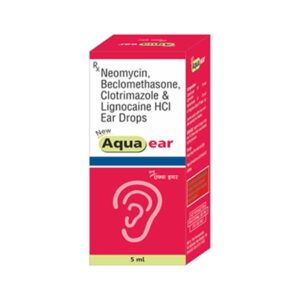BECLOMETHASONE + LIGNOCAIN + NEOMYCIN AND CLOTRIMAZOLE
Beclomethasone: Beclomethasone is a medication that belongs to the class of drugs known as corticosteroids. It is primarily used as an anti-inflammatory drug, especially in the treatment of asthma and allergic rhinitis.
The main mechanism of action of beclomethasone is to reduce inflammation in the airways. It works by suppressing the immune system and inhibiting the release of various inflammatory substances. This helps to decrease the inflammation in the airways, leading to improved breathing and reduced symptoms.
Beclomethasone is usually administered through inhalation by using an inhaler or a nebulizer. The recommended dose for adults and children over 12 years old is generally between 40 and 320 micrograms per day, divided into two to four doses. For children aged 5-12 years, the usual dose is 40-160 micrograms per day, while for children under 5 years old, the dose is typically 40-80 micrograms per day. The exact dosage and frequency of use should be determined by a healthcare professional based on individual needs and response to treatment.
While beclomethasone is an effective medication for asthma and allergic rhinitis, it can also cause some side effects. Common side effects include sore throat, hoarseness, cough, and a fungal infection in the mouth known as thrush. Rinsing the mouth and throat with water after each inhalation can help reduce the risk of thrush. Long-term use of high doses of beclomethasone may also increase the risk of systemic side effects, such as adrenal suppression, osteoporosis, and skin thinning. It is important to follow the prescribed dose and consult a healthcare professional if any side effects occur.
Overall, beclomethasone is an effective corticosteroid medication used in the management of asthma and allergic rhinitis. It helps to reduce airway inflammation and improve symptoms, but it is important to use it as directed and be aware of its potential side effects.
Lignocain: Lignocain, also known as Lidocaine, is a medication used primarily as a local anesthetic. It is commonly used to numb an area of the body during medical or dental procedures, surgeries, or to alleviate pain from minor skin irritations or burns.
The mechanism of action of Lignocain involves blocking the initiation and conduction of nerve impulses by inhibiting the voltage-gated sodium channels in the cell membranes. By preventing the influx of sodium ions into nerve cells, it inhibits the generation and transmission of pain signals.
The dosage of Lignocain depends on the specific procedure or condition being treated. In general, it is available in various forms, including creams, gels, ointments, sprays, and injections. The dosage and application method vary depending on the intended use. It is important to follow the instructions provided by the healthcare professional or the product label.
Like any medication, Lignocain can have side effects. Common side effects include temporary numbness or tingling at the application site, itching, redness, or swelling. If these side effects persist or worsen, it is recommended to consult a healthcare professional.
Although rare, severe side effects can occur if Lignocain is absorbed into the bloodstream in large amounts or administered incorrectly. These include dizziness, confusion, seizures, irregular heartbeat, difficulty breathing, or allergic reactions such as hives or swelling. If any of these symptoms occur, immediate medical attention should be sought.
Lignocain should be used with caution in individuals with certain medical conditions such as liver disease, heart problems, or allergies to local anesthetics. It is also important to inform healthcare professionals about any medications or supplements being taken to avoid potential interactions.
In summary, Lignocain is a local anesthetic used for pain management during medical procedures or to alleviate minor topical pain. It works by blocking nerve signals. While generally safe, it is important to follow dosage instructions and be aware of potential side effects.
Neomycin And Clotrimazole: Neomycin and Clotrimazole is a combination drug that is commonly used to treat fungal and bacterial infections of the skin. It is available in various forms, such as creams, ointments, and powders.
Neomycin is an antibiotic that belongs to the aminoglycoside class. It works by inhibiting the growth and multiplication of bacteria by interfering with protein synthesis. It is effective against a wide range of bacteria, including Staphylococcus and Escherichia coli.
Clotrimazole is an antifungal medication that belongs to the class of azole drugs. It works by inhibiting the synthesis of ergosterol, an essential component of the fungal cell membrane. This disruption ultimately leads to the death of the fungus.
The combination of neomycin and clotrimazole provides a broad spectrum of activity against both bacteria and fungi, making it useful in the treatment of mixed infections or when the specific organism causing the infection is unknown.
The exact dose of Neomycin and Clotrimazole depends on the specific product being used and the severity of the infection. It is typically applied to the affected area 2-3 times a day, following proper cleansing and drying of the skin.
Like any other medication, Neomycin and Clotrimazole can cause side effects. The most common side effects include rash, itching, redness, and burning at the application site. Allergic reactions may occur in some individuals, leading to swelling, hives, or difficulty breathing. If any severe side effects occur, such as increased irritation or worsening of symptoms, medical attention should be sought immediately.
It is essential to use Neomycin and Clotrimazole as directed by a healthcare professional and to complete the full course of treatment, even if the symptoms improve. This helps in preventing the recurrence of the infection and development of drug resistance.

